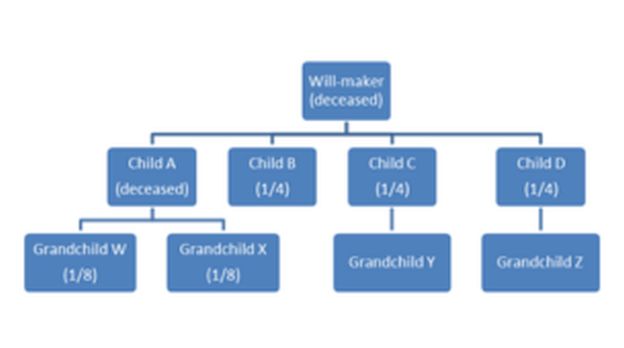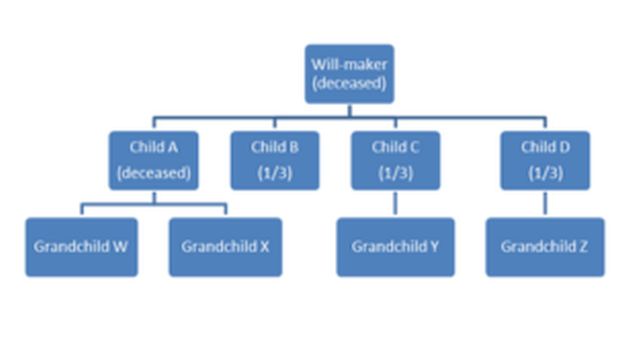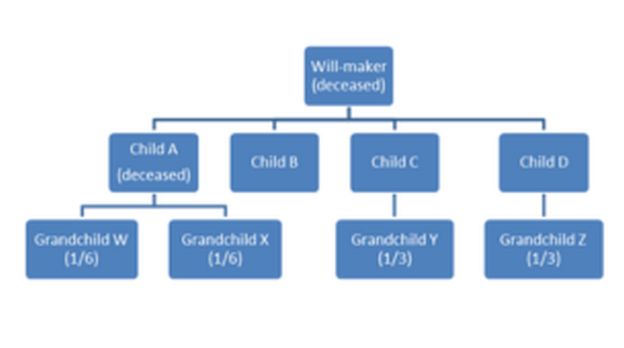- with readers working within the Law Firm industries
- with readers working within the Law Firm industries
- with Senior Company Executives, HR and Finance and Tax Executives
If you have ever read a Will or taken an estate planning class,
you might have encountered familiar words being used in unusual
ways (such as property being given to a person's
"issue"), or new terms you have never seen before (such
as "per stirpes").
In the context of Wills, a person's "issue" means
their closest-living direct lineal descendants (i.e. their
children, grandchildren, and great-grandchildren) who are related
to the person either biologically or by legal adoption.
"Issue" does not include step-children or non-lineal
relatives such as nieces and nephews.
"Per stirpes" is a Latin phrase that means "by
branch". In the context of Wills, this legal term is a concise
way to explain a specific type of property distribution among a
person's issue. It essentially means that if a person named in
the Will is dead but left surviving descendants, that dead
person's share of the estate would flow down to their children,
grandchildren, etc. (i.e. their inheritance stays inside their
'branch' of the family).
For example, say a person has four children, and in their Will they
leave their entire estate to their "issue in equal shares per
stirpes." This would mean each of the four children is
entitled to receive ¼ of the estate. If one of the
Will-maker's children died before the Will-maker, but left
surviving children of their own, then that dead child's
¼ of the estate would flow down their 'branch' of
the family to be split equally among their children (the
Will-maker's grandchildren).
Example of distribution among issue per stirpes
The usefulness of "per stirpes" has made it
common-place in Wills, but unfortunately, the underlying meaning of
the term is sometimes overlooked by drafting lawyers. The words
"per stirpes" necessarily refer to 'branches' of
a family and describe how property flows down a 'branch' to
younger generations if members of the older generation have
predeceased the Will-maker; therefore, a distribution "per
stirpes" cannot be limited to one generation. This may seem
like splitting hairs, but significant problems can arise when the
term "per stirpes" is incorrectly used to refer to a
distribution among a specific generation.
Consider how one would interpret a Will that gives all property to
the Will-maker's "children in equal shares per
stirpes." The language is clear that the distribution is
limited only to the Will-maker's children, meaning there is no
way for the inheritance to flow down to younger generations if any
child predeceases the Will-maker, rendering the term "per
stirpes" inoperable. It is an oxymoron to use the term
"per stirpes" in relation to a distribution among any
specific generation of a family.
To illustrate the problem, if we used our example chart above and
applied a distribution to the Will-maker's "children in
equal shares per stirpes," it would result in deceased Child
A's children receiving nothing from the estate:

Example of distribution among issue per stirpes
Example of distribution among children per stirpes
This is troubling because, by using the term "per
stirpes," it seems that the Will-maker intended to provide for
their grandchild(ren) if the grandchild(ren)'s parent
predeceased the Will-maker; however, because the term per stirpes
was used in relation to a specific generation, this intention
cannot be realized after the Will-maker's death without a court
application to clarify the meaning or vary the terms of the
Will.
What if our Will-maker left their estate to their
"grandchildren in equal shares per stirpes"? This was the
situation in a case before the Supreme Court of Canada in the 1960s
(Gettas v Karavos [1962] SCR 390). In that case, the Will-maker had
two daughters, one of whom had one child, while the other had three
children. As each 'branch' of the family had grandchildren,
the Supreme Court found that the phrase "per stirpes"
meant that the Will-maker wanted to benefit each 'branch'
of the family equally. Since the Will-maker had two daughters,
there were two 'branches' of the family, each entitled to
receive equal halves of the estate. As a result, the grandchild who
was an only child received half the estate (as she was the sole
grandchild in her 'branch' of the family), while the other
half of the estate was divided equally among the three
grandchildren in the other 'branch' of the family.
Using our example chart, if our Will-maker left their estate to
their "grandchildren in equal shares per stirpes," then
the estate would be divided into thirds (because only three
branches of the family include grandchildren), and distributed as
follows:

Example of distribution among children per stirpes
Example of distribution among grandchildren per stirpes
Evidently, strange and unintended property distributions may
result from improper use of the term 'per stirpes'. To
avoid this problem, when using the term "per stirpes,"
always pair it with the term "issue" and never with
"children", "grandchildren" or such other
language that limits the word to one generation. This is best
practice and our recommendation. Furthermore, whenever using the
term "issue", be sure it is clear to whose issue you are
referring.
It may be helpful to define the terms "per stirpes" and
"issue" within the Will itself, to assist in future
interpretation of the document; however, if such definitions are
included, care should be taken to ensure the terms maintain their
commonly understood legal meanings. Alternatively, it is possible
to avoid using "per stirpes" entirely when drafting a
Will, although this should be done thoughtfully and with attention
to including appropriate alternative gifting provisions.

The content of this article is intended to provide a general guide to the subject matter. Specialist advice should be sought about your specific circumstances.



